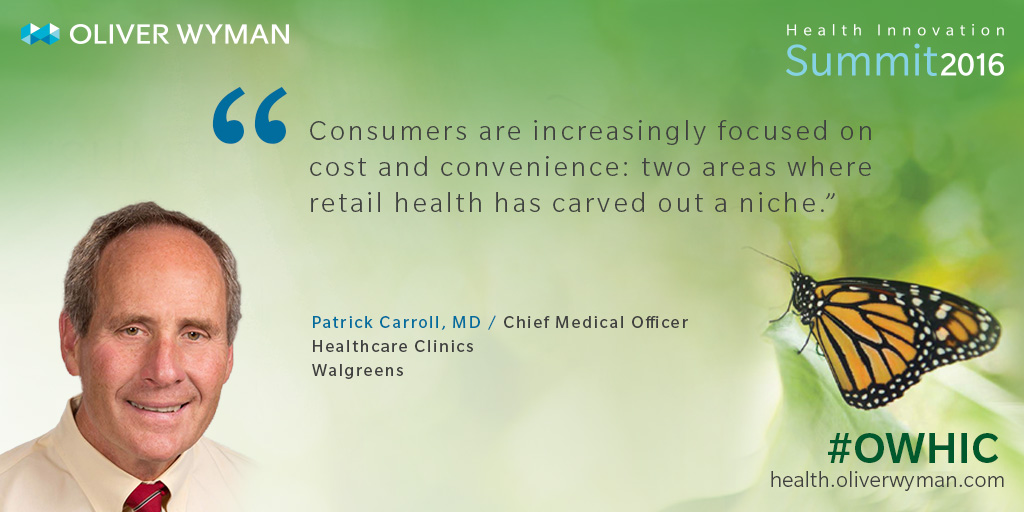At the 2016 Oliver Wyman Health Innovation Summit, Patrick Carroll, MD, Chief Medical Officer of Healthcare Clinics at Walgreens, will participate in a panel discussion titled “The New Front Door: How to Get Folks Knocking.” Here, he shares his thoughts on the future of retail clinics and offers perspective on why consumers have been slow to embrace alternative sites of care.
Oliver Wyman Health: We’ve seen an increased use of retail clinics in the past few years, but our latest research shows that only about a quarter of consumers have used one in the past year. Why do you think the adoption to the “new front door” is moving slowing?
Patrick Carroll: The slow adoption can be attributed to the lack of awareness of services that are offered at retail clinics. Consumers don’t always associate a retail environment, like a drug store, with offering healthcare. Or they may be unsure about who will be delivering the care. That’s why we think there is value in working together with health systems [Walgreens has partnered with health systems to staff and operate its clinics] since they are established trusted providers in their communities.
OWH: What will take to speed up the use of the new front door, including retail clinics, telehealth, etc.?
PC: The healthcare landscape is evolving rapidly, both nationally and locally. Changes like the Affordable Care Act, health systems’ value-based care models, and the retail-ization of healthcare all influence the way consumers access healthcare services. Market forces such as high deductible health plans will lead consumers to retail health for high-quality affordable healthcare. Consumers are increasingly focused on cost and convenience: two areas where retail health has carved out a niche. The growing numbers of retail clinics will also increase visibility.
Our data shows that 40 percent of Healthcare Clinic patients say if it weren’t for our clinics, they would either go to a more costly point of care or may not seek treatment at all – potentially resulting in greater complications and more significant costs in the long run. Retail clinics play an important role in healthcare today by providing affordable care to millions of patients.
Connectivity should not be underestimated. There is great value in being on the same EMR platform as the partnered health system.
OWH: Over the past several years we’ve seen a shift from basic services (e.g., flu shots) to disease management and coaching programs offered at retail clinics. What can we expect in the future?
PC: Because of the primary care shortage, we have to do more in the area of chronic disease management. We believe offering a wide range of services will help clinics bridge the gap in primary care access and increase the overall volume of patients. As we assess the ongoing needs of the patients coming in for the expanded services we will determine if there are additional unmet care needs that we can address (that are within the scope of practice of our NPs/PAs).
OWH: Would you briefly explain why Walgreens chose to partner with provider organizations on your retail clinics? How might this approach accelerate adoption of the new front door?
PC: Partnerships are just one of the ways that we are evolving our business to meet the needs of our patients. We have entered into discussions with select health systems to explore a collaborative services model that fully integrates retail clinics into the health system care plan and care continuum.
[To better integrate alternate sites of care], there needs to be much better connectivity on electronic medical records and more buy-in from primary care providers. That’s why we pursued the health system affiliation model, because we believe health systems will have a simpler time bridging that gap.
OWH: How do you see the new front door integrating in the broader market 2.0 landscape? How can payers and providers better leverage these types of services/locations for optimal patient care?
PC: As the cost and quality risk is shifted to providers and health systems, the access and quality that retail health offers will be increasingly recognized by both payers and providers. Retail health should be viewed as part of the medical home. Connectivity should not be underestimated. There is great value in being on the same EMR platform as the partnered health system.
